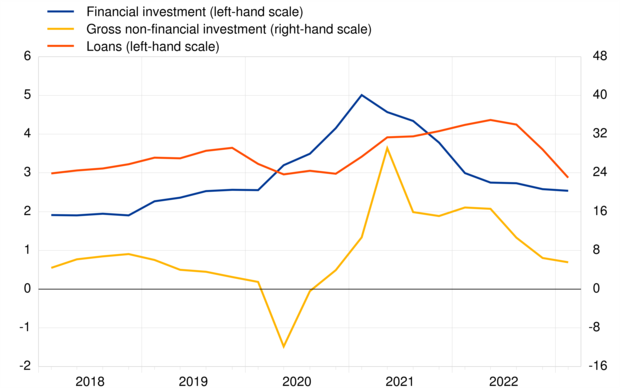- STATISTICAL RELEASE
Households and non-financial corporations in the euro area: first quarter of 2023
4 July 2023
- Households' financial investment increased at broadly unchanged annual growth rate of 2.5% in first quarter of 2023, after 2.6% in previous quarter
- Non-financial corporations' financing increased at lower annual rate of 1.5%, after 2.0%
- Non-financial corporations' gross operating surplus grew at unchanged annual rate of 9.9%
Chart 1
Household financing and financial and non-financial investment
(Annual growth rates)

Chart 2
NFC gross-operating surplus, non-financial investment and financing
(annual growth rates)

Source: ECB and Eurostat
Households
Household gross disposable income increased in the first quarter of 2023 at an annual growth rate of 8.4% (after 7.9% in the fourth quarter of 2022). Compensation of employees grew at a higher rate of 7.1% (after 6.6%), and gross operating surplus and mixed income of the self-employed increased at a higher rate of 8.9% (after 7.5%). Household consumption expenditure grew at a lower rate of 9.2%, after 9.6%.
Household gross saving rate in the first quarter of 2023 was 13.6%, compared with 13.8% in the previous quarter.
Household gross non-financial investment (which refers mainly to housing) increased at a lower annual rate of 5.5%, after 6.4% in the previous quarter. Loans to households, the main component of household financing, grew at a lower rate of 2.9% (after 3.6%).
Household financial investment increased at a broadly unchanged annual rate of 2.5% in the first quarter of 2023, after 2.6% in the previous quarter. Among its components, currency and deposits grew at a lower rate of 2.2% (after 3.8%), while investment in debt securities as well as in shares and other equity grew at higher rates (48.3% after 22.2%, and 1.7% after 0.9%, respectively). Investment in life insurance increased at an unchanged rate (1.0%), and investment in pension schemes grew at a lower rate (2.2%, after 2.4%).
Household net worth grew at an annual rate of 2.7% in the first quarter of 2023, after 1.4% in the previous quarter. The acceleration was mainly due to lower valuation losses on financial assets in the four quarters to the first quarter of 2023, while housing wealth, the main component of non-financial assets, grew at a lower rate of 5.4%, after 6.9%. The household debt-to-income ratio decreased to 91.1% in the first quarter of 2023 from 95.3% in the first quarter of 2022.
Non-financial corporations
Net value added by NFCs increased at a higher annual rate of 9.8% in the first quarter of 2023, after 9.2% in the fourth quarter of 2022. Gross operating surplus grew at an unchanged rate of 9.9%, while net property income (defined in this context as property income receivable minus interest and rent payable) decreased at a lower rate (-3.5%, after -9.1%). As a result gross entrepreneurial income (broadly equivalent to cash flow) increased at a higher rate of 8.4% (after 7.2%).[1]
NFCs’ gross non-financial investment increased at a lower annual rate of 0.7%, compared to 2.7% in the previous quarter. This deceleration was due to a lower growth rate of net acquisition of other non-financial assets such as inventories, while gross-fixed capital formation increased at a higher rate (10.6% after 7.3%).[2] NFCs’ financial investment grew at an annual rate of 2.5%, after 3.0%. Among its components, currency and deposits and loans granted grew at lower rates of 0.7% after 5.1%, and 3.4% after 3.9%, respectively. Investment in shares and other equity grew at a lower rate as well (1.3%, after 1.8%), while investment in debt securities accelerated (21.2%, after 13.3%).
Financing of NFCs increased at a lower annual rate of 1.5% (after 2.0%), reflecting lower growth rates of financing via loans[3] (3.2%, after 4.2%), shares and other equity (0.8%, after 1.0%), trade credits (3.3%, after 3.9%) and debt securities (-0.4%, after 0.7%). NFCs’ debt-to-GDP ratio (consolidated measure) decreased to 72.7% in the first quarter of 2023, from 77.5% in the same quarter of the previous year; the non-consolidated, wider debt measure decreased to 133.4% from 140.8%.
For queries, please use the Statistical information request form.
Notes
- This statistical release incorporates revisions to the data since the first quarter of 2019, reflecting the inclusion of Croatia in the euro area aggregates, which now cover all 20 members of the euro area. These revisions did not significantly alter the figures previously published, which referred to the first 19 members of the euro area only.
- The annual growth rate of non-financial transactions and of outstanding assets and liabilities (stocks) is calculated as the percentage change between the value for a given quarter and that value recorded four quarters earlier. The annual growth rates used for financial transactions refer to the total value of transactions during the year in relation to the outstanding stock a year before.
- The euro area and national financial accounts data of non-financial corporations and households are available in an interactive dashboard.
- Hyperlinks in the main body of the statistical release are dynamic. The data they lead to may therefore change with subsequent data releases as a result of revisions. Figures shown in annex tables are a snapshot of the data as at the time of the current release.
Gross entrepreneurial income is the sum of gross operating surplus and property income receivable minus interest and rent payable.
Gross non-financial investment is the sum of gross fixed capital formation, changes of inventories, and the net acquisition of valuables and non-produced assets (e.g. licences).
Loan financing comprises loans granted by all euro area sectors (in particular MFIs, non-MFI financial institutions and loans from other non-financial corporations) and by creditors that are not resident in the euro area.


